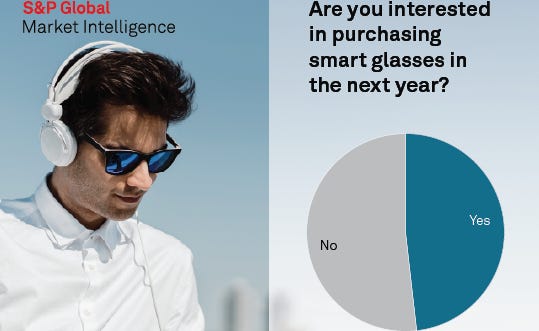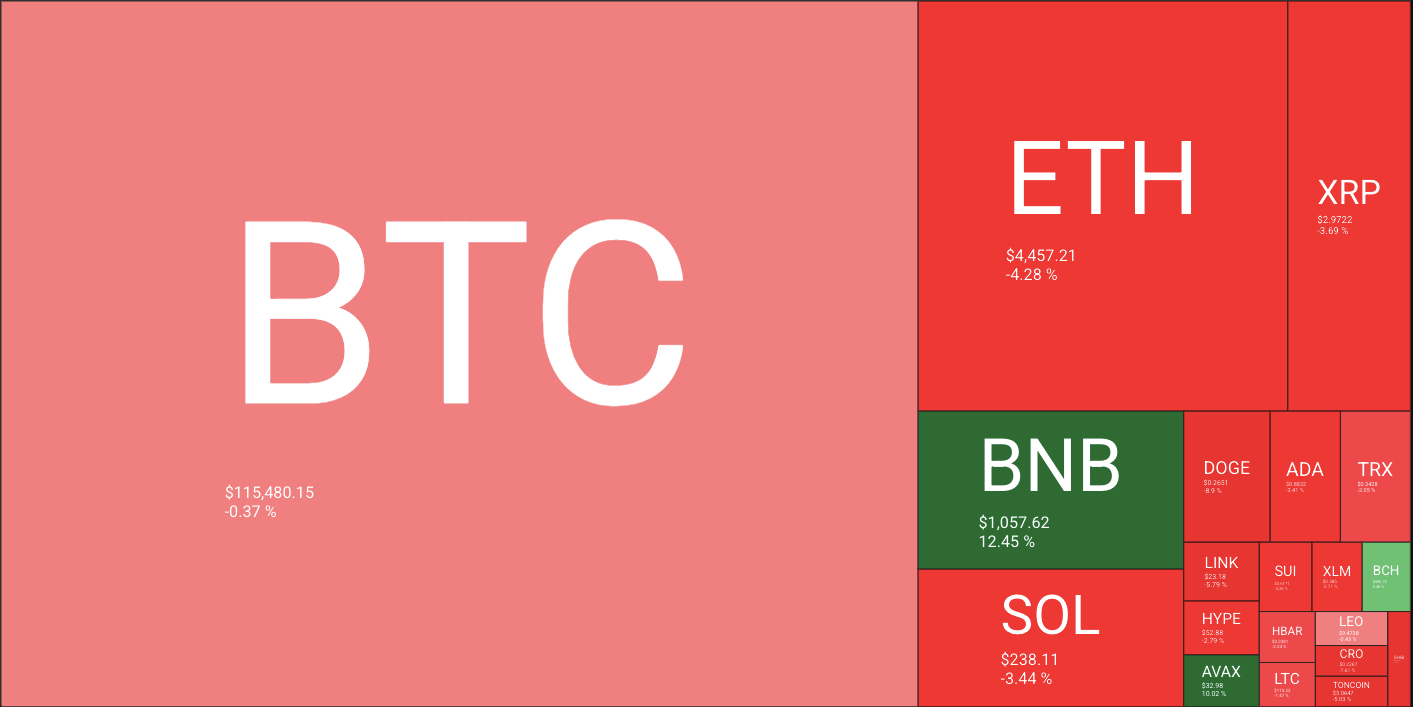Weekly Journal: Smart Glasses Gain Edge Over VR as Consumer Demand Rises
[6 min read] Your weekend guide to getting ahead on the digital frontier. A survey of 4000 adults shows 48.2% of respondents are considering buying a pair within the next year.
Welcome to this week’s Weekly Journal 📔, your guide to the latest news & innovation in emerging technology, digital assets, and our exciting path to the Metaverse. This is week 146 of the 520 weeks of newsletters I have committed to, a decade of documenting our physical and digital lives converge. New subscribers are encouraged to check out the history & purpose of this newsletter as well as the archive.
- Ryan
🌐 Digital Assets Market Update
To me, the Metaverse is the convergence of physical & virtual lives. As we work, play and socialise in virtual worlds, we need virtual currencies & assets. These have now reached mainstream finance as a defined asset class:
🔥🗺️Heat map shows the 7 day change in price (red down, green up) and block size is market cap.
🎭 Crypto Fear and Greed Index is an insight into the underlying psychological forces that drive the market’s volatility. Sentiment reveals itself across various channels—from social media activity to Google search trends—and when analysed alongside market data, these signals provide meaningful insight into the prevailing investment climate. The Fear & Greed Index aggregates these inputs, assigning weighted value to each, and distils them into a single, unified score.
🗞️ Metaverse news from this week:
Survey: Nearly Half of Consumers Eye Smart Glasses as Next Step into the Metaverse
A new 2025 consumer survey of 4000 adults from around the world shows 48.2% of respondents without smart glasses are considering buying a pair within the next year—outpacing interest in VR headsets by seven percentage points. Nearly a quarter of respondents already own smart glasses, with adoption highest in the Asia-Pacific region (35%).
Meta’s Ray-Ban line leads the category, with Amazon a distant second. Other players like ASUS, Lenovo, and RayNeo are finding traction regionally, particularly in Asia-Pacific. While not yet mainstream, Meta’s marketing-driven momentum has given it an early lead, especially with Apple, Samsung, and Google’s plans still under wraps.
The results reflect a major shift in the metaverse hardware landscape: consumers appear more drawn to lightweight, everyday eyewear that blends physical and digital realities, rather than bulky VR headsets. Despite VR’s deeper software ecosystem, interest remains strong (40% still considering purchase), though adoption lags due to price and content gaps.
For the metaverse, the data signals a tipping point: display-driven smart glasses could become the default entry point for digital-physical convergence, shaping how mainstream users first experience persistent, immersive worlds.
ArtGis Finance Partners with MetaXR to Bring DeFi Deeper into the Metaverse
ArtGis Finance, a DeFi platform bridging blockchain and traditional finance, has entered into a strategic partnership with MetaXR, a crypto-powered extended reality network. The collaboration integrates MetaXR’s VR/AR/metaverse infrastructure with ArtGis’ DeFi trading network, enabling seamless access to digital assets inside immersive virtual environments.
The deal positions ArtGis tokens as core enablers of commerce and trading in metaverse spaces, while MetaXR benefits from multi-chain and cross-chain bridges built into ArtGis’ DeFi ecosystem. Users can now interact with digital assets directly inside MetaXR’s metaverse, engaging in trading, settlement, and even play-to-earn activities.
For the broader Web3 landscape, this partnership underscores a growing convergence: DeFi liquidity meets metaverse utility. Where previous DeFi integrations were mostly wallet- and DEX-based, ArtGis and MetaXR are pushing toward spatial finance—a model where financial activity is embedded within virtual worlds rather than separate from them.
Launched in 2019, ArtGis has pursued multiple collaborations to advance global digital asset flows. Its alliance with MetaXR reflects a wider ambition to redefine financial interaction through immersive technologies, hinting at a future where trading, lending, and staking occur as naturally in the metaverse as at a browser terminal.
📖 Read of the week: Stop Asking if the Metaverse is Dead. Ask if It’s Designed Right
🗞 The Drum | Opinion | 18 September 2025
This article flips the tired “Is the metaverse dead?” narrative on its head. Instead of debating hype cycles, it argues that the real question is whether today’s metaverse platforms are designed in ways that truly serve people, businesses, and culture.
Key insights:
🚫 Wrong question, wrong frame: The metaverse isn’t dying—it’s evolving. The more important focus is on design, usability, and purpose.
🛠️ Design challenges: Many current platforms prioritised novelty over functionality, leading to clunky user experiences and weak adoption.
🌍 What matters now: Seamless interoperability, compelling use cases, and human-centred design will define the metaverse’s staying power.
💡 From hype to utility: Just like the early internet, the metaverse will mature once it moves past gimmicks into real-world value—in work, commerce, culture, and play.
🔮 The takeaway: Don’t bury the metaverse. Redesign it. Done right, it’s still the infrastructure for the next generation of digital interaction.
🔗 Read the full article on The Drum
🎥 Watch of the week:
Marques Brownlee trying the Meta Rayban Display glasses. Remember, the Metaverse is the seamless convergence of our physical and digital lives, and AR hardware like these are a stepping stone to that.
AI Spotlight 🎨🤖🎵✍🏼: AI Showcase of the Week: Zuckerberg Bets on AI to Resurrect the Metaverse
In the Metaverse, AI will be critical for creating intelligent virtual environments and avatars that can understand and respond to users with human-like cognition and natural interactions.
At Meta Connect 2025, Mark Zuckerberg revealed how AI could finally breathe life back into the metaverse. Meta’s new agentic AI assistant will let anyone generate 3D spaces and objects in Horizon Worlds using simple text prompts, while Hyperscape Capture allows users to scan a real environment with a Quest headset and instantly recreate it in VR. These tools cut the cost and complexity of world-building, opening the door for enterprise use cases like immersive HR training, real estate tours, and global boardrooms. If AI makes designing virtual spaces as easy as typing an idea, the metaverse may shift from a stalled dream to an everyday workplace reality
That’s all for this week! If you have any organisations in mind that could benefit from keynotes about emerging technology, be sure to reach out. Public speaking is one of many services I offer.




